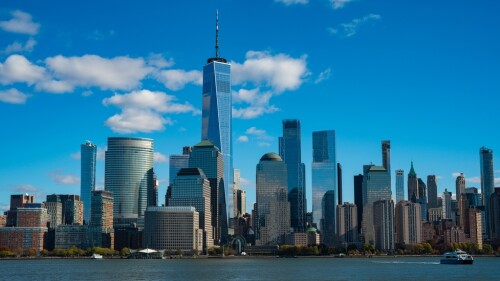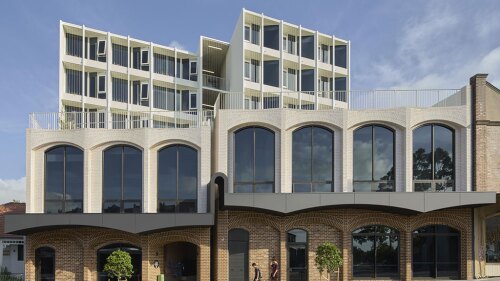In British sci-fi comic 2000 AD, Mega City One spread across the U.S. Eastern Seaboard, with a population of 800 million kept under the thumb of harsh lawman Judge Dredd. Today, on China’s southern coast, the integration of the Greater Pearl River Delta (PRD) is turning fiction into fact (sans the harsh lawman), with 11 cities linking to create an urban area of 21,100 square miles (55,000 sq km) and a population of up to 80 million.
Related: Capital Markets: A Global Perspective | Register for ULI Fall Meeting | More Upcoming Events
The nine cities of the PRD, plus the special administrative zones of Hong Kong and Macau, are becoming increasingly linked by a series of bridges, tunnels, roads, and high-speed rail networks. Today they have a total official population of 60 million, but the actual number is believed to be far higher once unregistered migrants are taken into account.
By 2030, these 11 separate cities will be part of a single urban area with a population that could be as high as 80 million and a gross domestic product (GDP) of more than $2 trillion, according to Michael Enright, director of Enright, Scott & Associates, who spoke at the ULI Asia Pacific Summit, held in Hong Kong in May.
Dawn of a Megalopolis
The seeds of change were planted in 2008, when the Chinese government unleashed a plan to merge the PRD’s cities—consisting of Shenzhen, Dongguan, and Huizhou in the east; Zhuhai, Zhongshan, and Jiangmen in the west; and Guangzhou, Foshan, and Zhaoqing in the center—into a single megalopolis. Spending of nearly 2 trillion renminbi (RMB) (US$322 billion) on more than 150 major infrastructure improvements is forging a colossal network of transportation, water, energy supply, and telecommunication facilities.
At the ULI summit, Sean Chiao, AECOM’s chief executive for buildings and places, said, “We can no longer think of the PRD with Hong Kong as the global gateway, but as an integrated megalopolis, with high-speed transport links bringing the cities together. Hong Kong needs to change its way of thinking from being a gateway or springboard to China to being a fully integrated part of this megalopolis.”
The plan involves more than just infrastructure. For now, due to China’s household registration system, or hukou, a person’s entitlement to public services such as health care, education, and pensions is tied to his or her place of birth. However, it is intended that the system will be abolished in the PRD in the coming years, enabling what is referred to as “barrier-free circulation” of public services. Inhabitants of the megalopolis will be able to attend school or stay at hospitals with a government subsidy in any of the nine cities. (The special administrative regions [SARs] of Hong Kong and Macau will remain outside the mainland China legal system).
Hong Kong chief executive C.Y. Leung spoke about the city’s plans to integrate with the PRD through an ambitious infrastructure program, the highlight of which is a 31-mile (50 km) bridge and tunnel linking Hong Kong, Zhuhai, and Macau, which is expected to open in 2016. Similarly, the 100-mile-long (161 km) Express Rail Link, with its terminus in West Kowloon, will reduce the travel time between Hong Kong and Guangzhou to a mere 48 minutes when it is operational in 2015. (At present, the travel time between the two cities is at least two hours by car or normal train service.)
“Here’s a lesson for all fast-growing cities: there’s no need for compromise in order to strike the right balance between building a city that is healthy for people, for business, and for the environment,” Leung said.
Improving the transport system so that it is efficient and affordable, while laying the groundwork for greater regional integration, are key parts of the government’s strategy for the future, he added.
“You can put a dollar value on connectivity,” says Enright. He points to the contrasting fortunes of Zhuhai and Shenzhen, both of which were sleepy delta towns with similar GDPs until they were granted Special Economic Zone status in 1980. However, Shenzhen was easier to access from Hong Kong than Zhuhai was, and Hong Kong was the source of most of the investment in the PRD. In 2013, Zhuhai’s GDP was $27.3 billion; in the same year, Shenzhen’s was $237 billion.
Greater connectivity will create a “one-hour living zone,” speakers said. This will encompass all nine cities in the delta along with what they called a three-hour economic sphere in the Greater Pearl River Delta. In the “one-hour city,” a whole new range of central business districts (CBDs) will be opened up to companies, and their employees will have nine cities—rather than just one—in which they might be able to live.
Hong Kong Supply and Demand
In the simplest of real estate terms, Hong Kong’s problem is a lack of space. An office vacancy rate of 4 percent might be good for existing owners of real estate, but it stifles the city’s economy because companies cannot afford to expand. Residential prices remain among the highest in the world, despite a range of cooling measures that were implemented last year.
Integration with the PRD allows Hong Kong to broaden its horizons beyond the few square miles of hilly territory in the city itself. Key to this are the infrastructure works underway in the region; the intent is that it will be possible to travel between any of the major urban areas in the PRD within an hour, which opens up a range of possibilities. It is a tough task, though; Hong Kong does not have an open border with mainland China, and each city in the PRD will remain independently governed.
AECOM’s Chiao said he believes that more integration is the answer. “There is a need for further cross-regional planning; this is fundamental—economic planning, land use, infrastructure, and ecological [planning]. Cities tend to compete and not have proactive cooperation. We need to take a holistic approach, a fully integrated approach.”
However, Enright argued that such idealistic cooperation is a fantasy. “You can’t invest on the basis of cooperation across the region because it doesn’t exist: Hong Kong tries to steal from Shenzhen, Shenzhen tries to steal from Dongguan, and Guangzhou tries to steal from everybody.”
It is arguable that fierce internal competition among cities will result in a better offer to the people and businesses within them. However, Enright said he expected that the current boom in office development would lead to an oversupply in the short-to-medium term as cities competed to attract business.
Nonetheless, signs of cooperation are emerging between Shenzhen and Hong Kong, neighbors across the border. Located within a half-hour commuting radius of Hong Kong and Shenzhen, the Qianhai Shenzhen-Hong Kong Modern Service Industry Cooperation Zone will focus on finance, logistics, and technology services. The new zone’s administration wants to work with Hong Kong to facilitate reforms in China’s financial market, and to build an offshore renminbi trading center to promote the internationalization of the Chinese currency.
Qianhai also offers space—both in physical and business terms—for Hong Kong’s financial services companies to expand. Some observers believe Hong Kong could suffer as a result and that business will move to Qianhai, but Credit Suisse analyst Christiaan Tuntono argues that the rise of Qianhai could actually benefit Hong Kong. In a research note, Tuntono said: “Instead of fearing whether Qianhai shall replace Hong Kong in the future, we think investors should think how Hong Kong shall rise with Qianhai in forming an even greater financial and services hub in East Asia in the years to come.”
U.S. developer Silverstein Properties set down a marker in Qianhai in March when it bid $2.1 billion (13.4 billion RMB) to win a land sale alongside Shenzhen Qianhai International Energy Financial Center. The partners plan to build a 5.1 million-square-foot (477,000 sq m) development with 3.2 million square feet (300,000 sq m) of office space.
Rick Vogel, president of Silverstein Properties China, says Qianhai offers connectivity, the political will to succeed, and prodevelopment policies. “If we had opted to build our first development in Shanghai, we would have been alongside other foreign firms, but now we are a first-mover with a prime waterfront site,” he said. “What’s happening in the PRD makes it the most exciting part of what is happening in China.”
Hong Kong’s real estate companies have been at the forefront of investment in the PRD, and further integration will increase this. In a recent research report, Daiwa Capital Markets analyst Jonas Kan said: “We think one implication of Hong Kong/mainland integration is that some Hong Kong corporations could find their expertise has the opportunity to be applied to a much larger territory. We think there are a few companies in Hong Kong whose ability to manage their core businesses is world-class.”
Kan said that MTR Corporation (MTRC), which owns and manages Hong Kong’s subway network as well as associated real estate developments, will see significant business as the SAR integrates with China. MTRC already has operations in China; and as the need for connectivity increases, more cities may require MTRC’s skills.
The Link REIT, Asia’s largest real estate investment trust, with a reputation for extracting value from suburban retail in Hong Kong, plans to expand into the PRD on the back of the region’s integration.
“We believe that over the coming years, the dividing lines between Hong Kong and the Pearl River Delta will become increasingly blurred from an economic point of view as the two regions blend together and become increasingly interconnected,” chief executive George Hongchoy says.
Link REIT is teaming up with Vanke, China’s largest private residential developer, to own and manage retail in the PRD.
The integration of the Greater PRD is not without its problems, however. For Hong Kong, these are chiefly political; the city is expressing rising dissatisfaction with Chinese rule, particularly with regard to the move toward universal suffrage in the election to decide the next chief executive in 2017. Resentment toward mainland tourists and investors—who are blamed for rising retail prices and rising apartment prices—is as high as it has ever been.
Hundreds of thousands of protestors took to the streets on July 1 to demand more accountability and for Beijing to take a lighter approach to its governance of Hong Kong. In light of this atmosphere, plans to further integrate with the PRD are controversial.
A focus of protest has been plans to build three new towns near the border with Shenzhen—a move supported by Leung, who has said the new towns are necessary to ease the city’s housing burden. However, those who oppose the scheme see it as part of a long-term plan to merge Shenzhen and Hong Kong and to subsume the SAR into the mainland.
Real estate investors looking at the PRD need to look to the future, says Enright. “For anyone who is looking to make a substantial real estate investment in this region, the big question is not what does the city look like today, but how will it look in ten years’ or 15 years’ time? What economic roles will it play and how does it stack up against its competitors? What is exciting is that the real estate investor is able not only to adapt to that picture but also to shape it.”
Mark Cooper is editor at AsiaProperty Publishing in Hong Kong.












